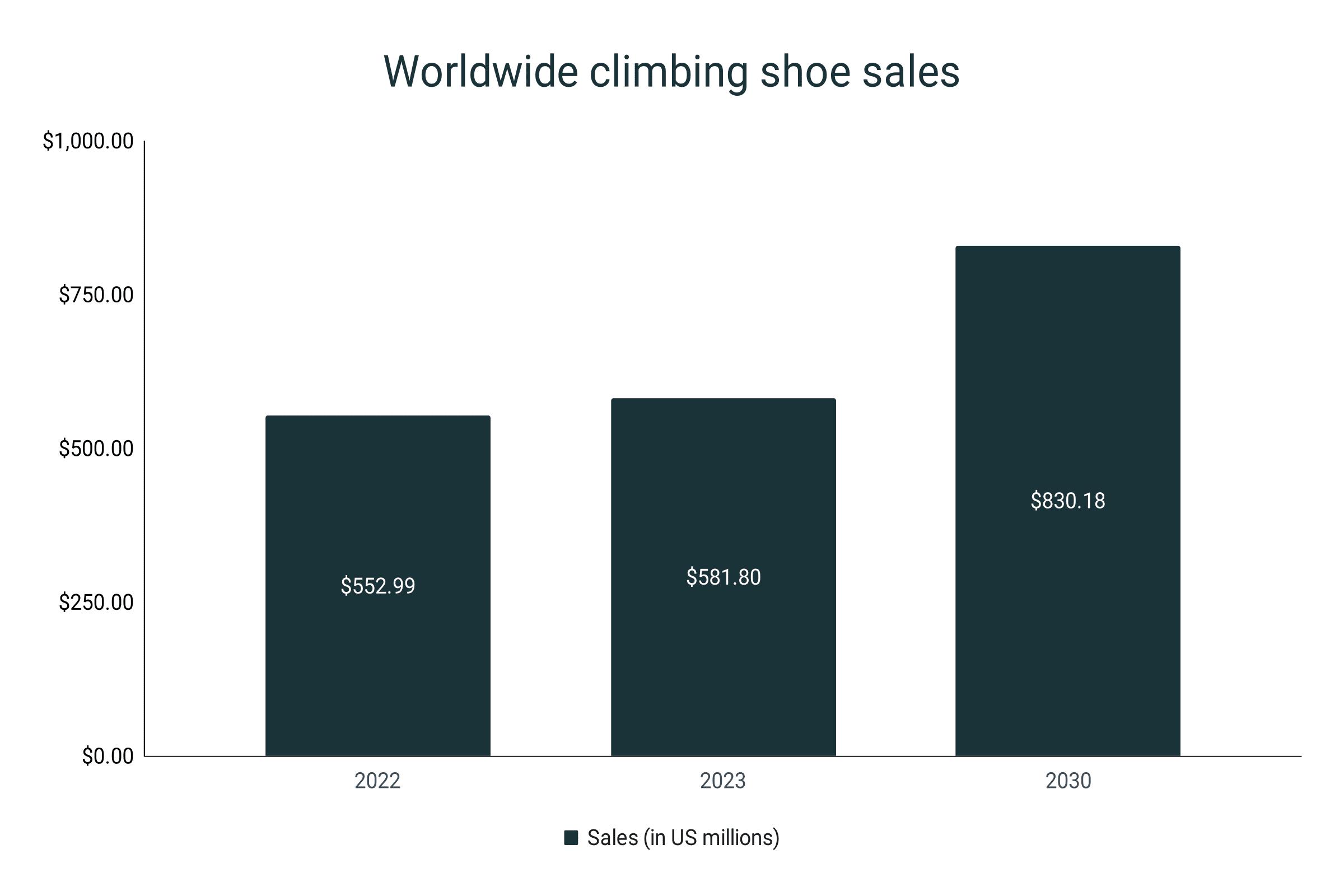Climbing and Mountaineering Shoes Statistics
Top climbing and mountaineering shoe stats
- Climbing footwear sales as of 2023 are at US$581.80 million, which is forecasted to increase to US$830.18 million by 2030.
- This projected figure is based on a CAGR of 5.21% between 2022 and 2030.
- Mountaineering boots come in 3 boot grades: B1, B2, and B3.
- 41 brands across the world manufacture mountaineering boots.
- Virtually 70% of these brands are of European origin.
- The projected 2023 mountaineering crampon sales are at US$1.33 billion.
- 134 different mountain climbing crampons were manufactured back in 2015.
- Based on 2015 data, automatic crampons were the most produced in the same year.
- Steel is the most widely used material in mountaineering footwear crampons.
Climbing footwear worldwide sales
- As of 2023, global revenue in climbing shoes sits at US$581.80 million.
- It is forecasted to increase at a 5.21% CAGR until 2030.
- By the end of the protection period, climbing footwear global sales are expected to reach US$830.18 million.
- That’s roughly a 50% sales growth from the 2023 worldwide revenue.
- In 2022, climbing footwear was valued at US$552.99 million globally.
|
Year |
Global sales (in US millions) |
|
2022 |
$552.99 |
|
2023 |
$581.80 |
|
2030 |
$830.18 |
Mountaineering boot grade stats
- B1 mountaineering boots are semi-stiff, 3-4 season boots.
- They are compatible with C1 crampons, which usually come with 10 points/spikes apiece.
- Stiffer than B1 models, B2 mountaineering boots are ideal for mid-grade ascents.
- These boots work well with 12-point C2 crampons.
- B3 mountaineering boots are intended for technical climbs and extreme elevations (up to 8000m and beyond).
- They are designed to take C3 crampons, which commonly have 14 spikes.
|
Boot grade |
Ideal crampon type |
No. of crampon points |
|
B1 |
C1 or Strap-on |
10 |
|
B2 |
C2 or Hybrid |
10-12 |
|
B3 |
C3 or Automatic |
12-14 |
Single and double mountaineering boots stats
- Single mountaineering boots are ideal for climbs of up to 5000m.
- They are usually the go-to on spring-weather ascents.
- Double mountaineering boots are for verticals beyond 5000m, giving extra protection in adverse weather conditions.
- Double mountaineering boots have removable liners.
- Those with integrated gaiters, whether single or double, can be used up to around 6500m.
Mountaineering boot brands
- As of 2023, there are 41 active mountaineering footwear brands.
- Europe has the most number of mountaineering boot manufacturers at 35.
- 18 or 50% of these European mountaineering bootmakers hail from Italy, including La Sportiva and Scarpa.
- North America has 3, including The North Face from the United States and Arc’Teryx from Canada.
- Lavan, an Iranian company, is part of the 3 known mountaineering boot brands in Asia.
|
Region |
No. of brands |
|
Europe |
35 |
|
North America |
3 |
|
Asia |
3 |
Mountaineering crampons global revenue
- As of 2023, worldwide revenue in mountaineering boot crampons sits at US$1.33 billion.
- This figure is expected to grow at a CAGR of 4.5% by 2030.
- At the end of the 2017-2030 forecast period, global mountaineering crampon sales are projected to reach US$1.81 billion.
- Based on the 2023 numbers, the 2030 projected revenue translates to a sales growth of roughly 36%.
- In 2017, global crampon sales broke through the 1 billion mark at US$1.02 billion.
|
Year |
Sales (in US billions) |
|
2017 |
$1.02 |
|
2023 |
$1.33 |
|
2030 |
$1.81 |
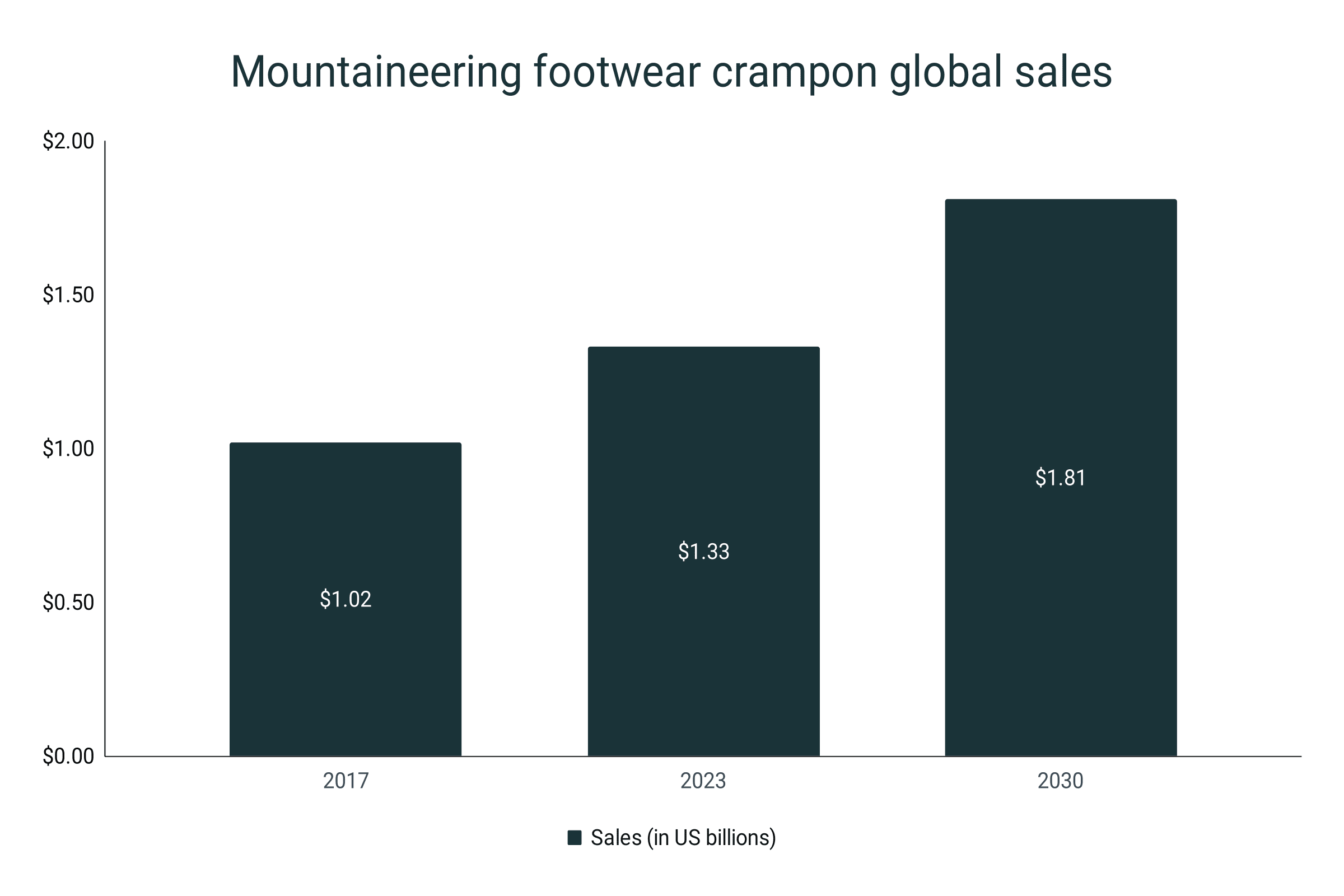
Production of mountaineering footwear crampons
- As of 2015, an average of 8 crampon models were made across major brands.
- Grivel produced the most number of mountaineering boot crampons at 21.
- CAMP came in second, manufacturing a total of 15 different crampon models.
- Black Diamond, Petzl, and Austri Alpin each produced 13.
- The least amount of crampon SKUs manufactured was 1, a number shared by both Climb X and Rock Empire.
- Edelrid’s 3 crampon models can be switched between hybrid and automatic modes.
|
Brand |
No. of crampon models produced |
|
Austri Alpin |
13 |
|
Black Diamond |
13 |
|
CAMP |
15 |
|
Cassin |
3 |
|
Climbing Technology |
12 |
|
Climb X |
1 |
|
Edelrid |
3 |
|
Grivel |
21 |
|
Ice Rock |
2 |
|
Kong |
6 |
|
Petzl |
13 |
|
Rock Empire |
1 |
|
Salewa |
6 |
|
Simond |
9 |
|
Singing Rock |
7 |
|
Stubai |
9 |
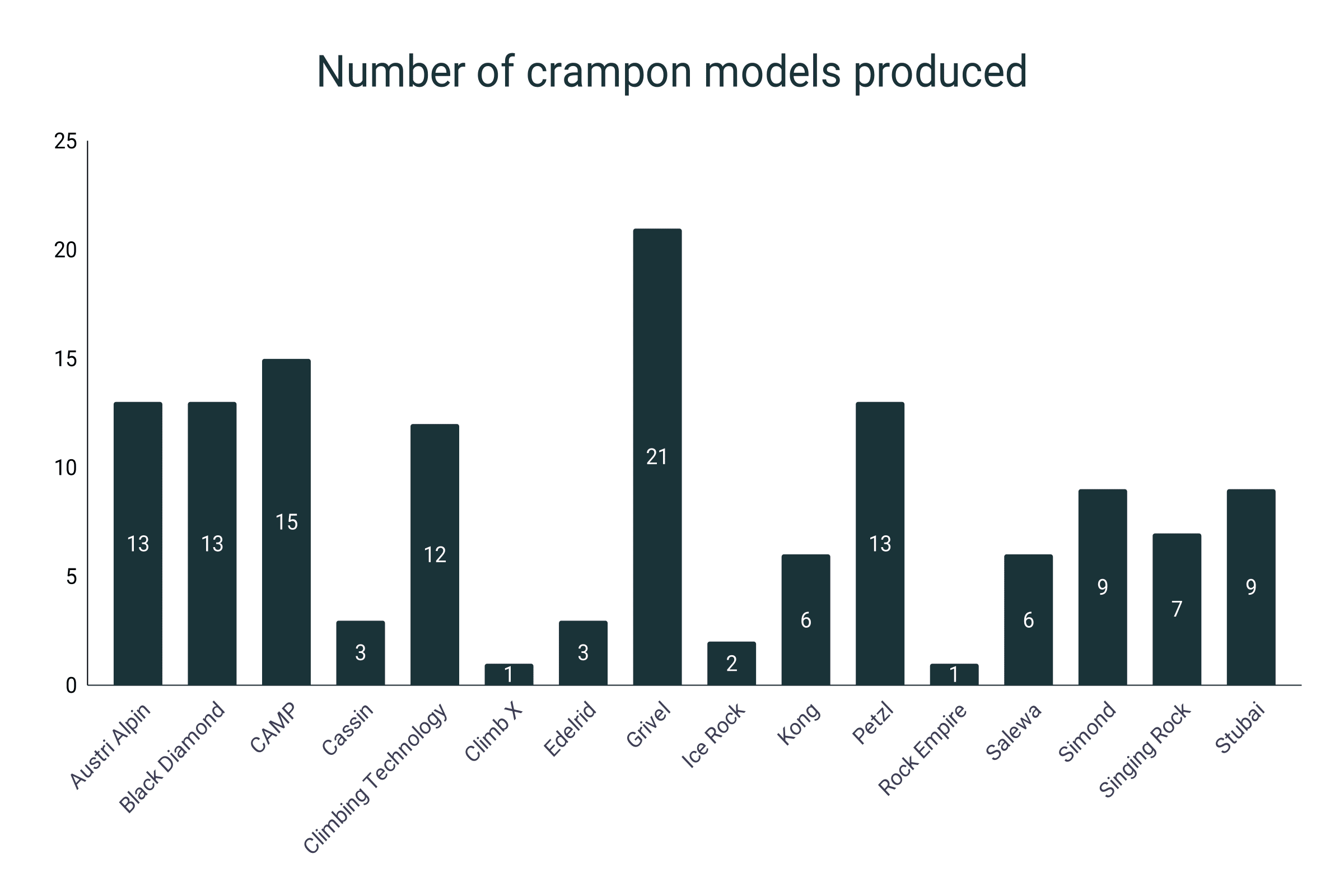
Mountaineering crampon models by binding type
- 36.4% of mountaineering crampons available as of 2015 were automatic (step-in) crampons.
- Semi-auto ones or C2 crampons were at 33.6%.
- About 28.6% of available crampons in 2015 were universal/strap-on crampons.
- Only 1.4% of crampons manufactured were bolt-on types.
- These percentages are based on 140 different crampon models.
|
Crampon binding type |
No. of models manufactured |
|
Strap-on |
40 |
|
Hybrid |
47 |
|
Automatic |
51 |
|
Bolt-on |
2 |
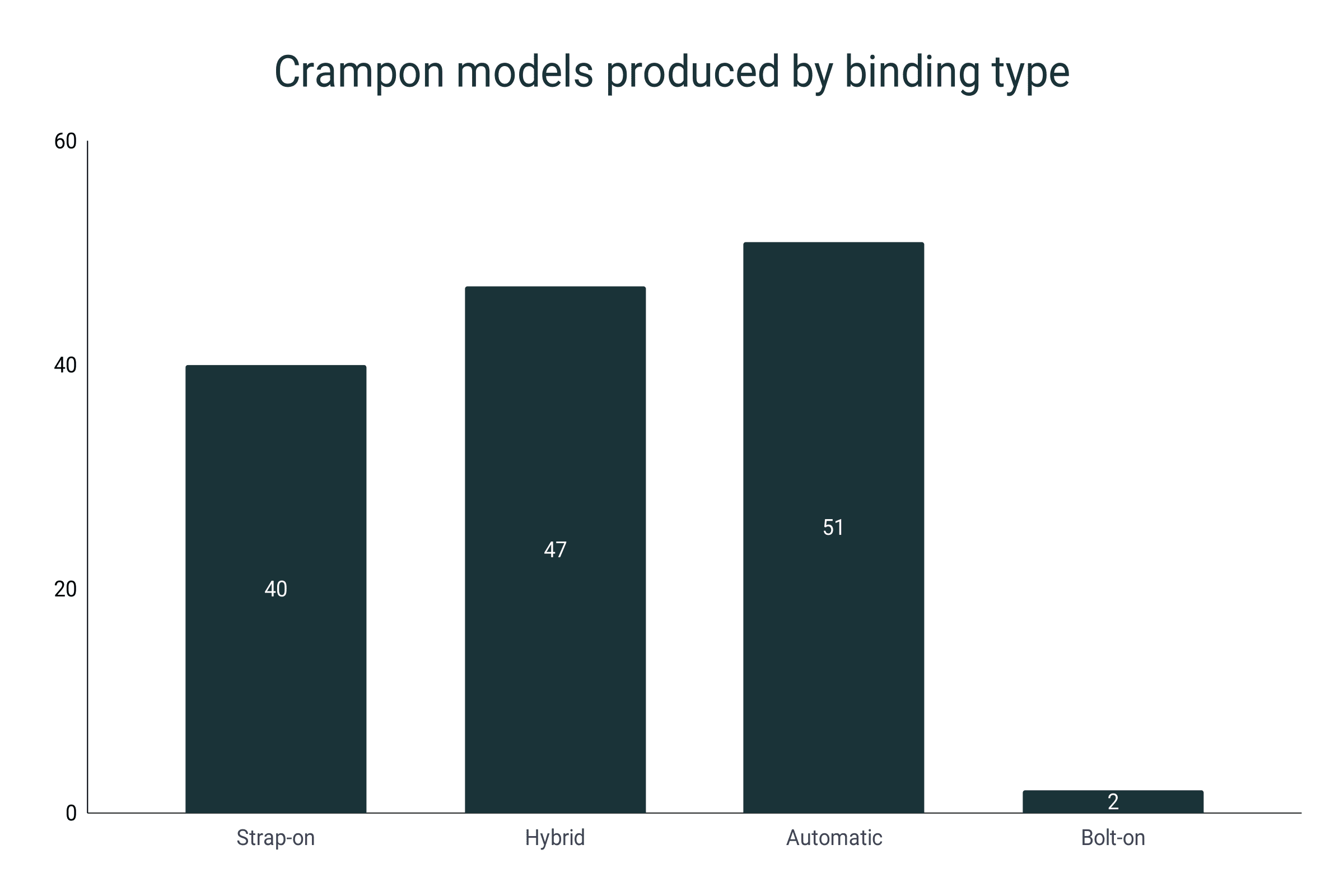
Mountaineering crampon material stats
- 109 or 80.1% of the manufactured mountaineering crampons as of 2015 were made of steel.
- About 16.9% or 23 crampon models made of aluminum were produced in the same year.
- The massive difference between steel and aluminum points to the longevity and practicality of the former despite the weight savings offered by the latter.
- A combination of steel and aluminum was used in only 2.9% of the produced crampon in 2015.
- That’s a total of 4 unique hybrid SKUs.
|
Crampon material |
No. of models manufactured |
|
Steel |
109 |
|
Aluminum |
23 |
|
Hybrid |
4 |
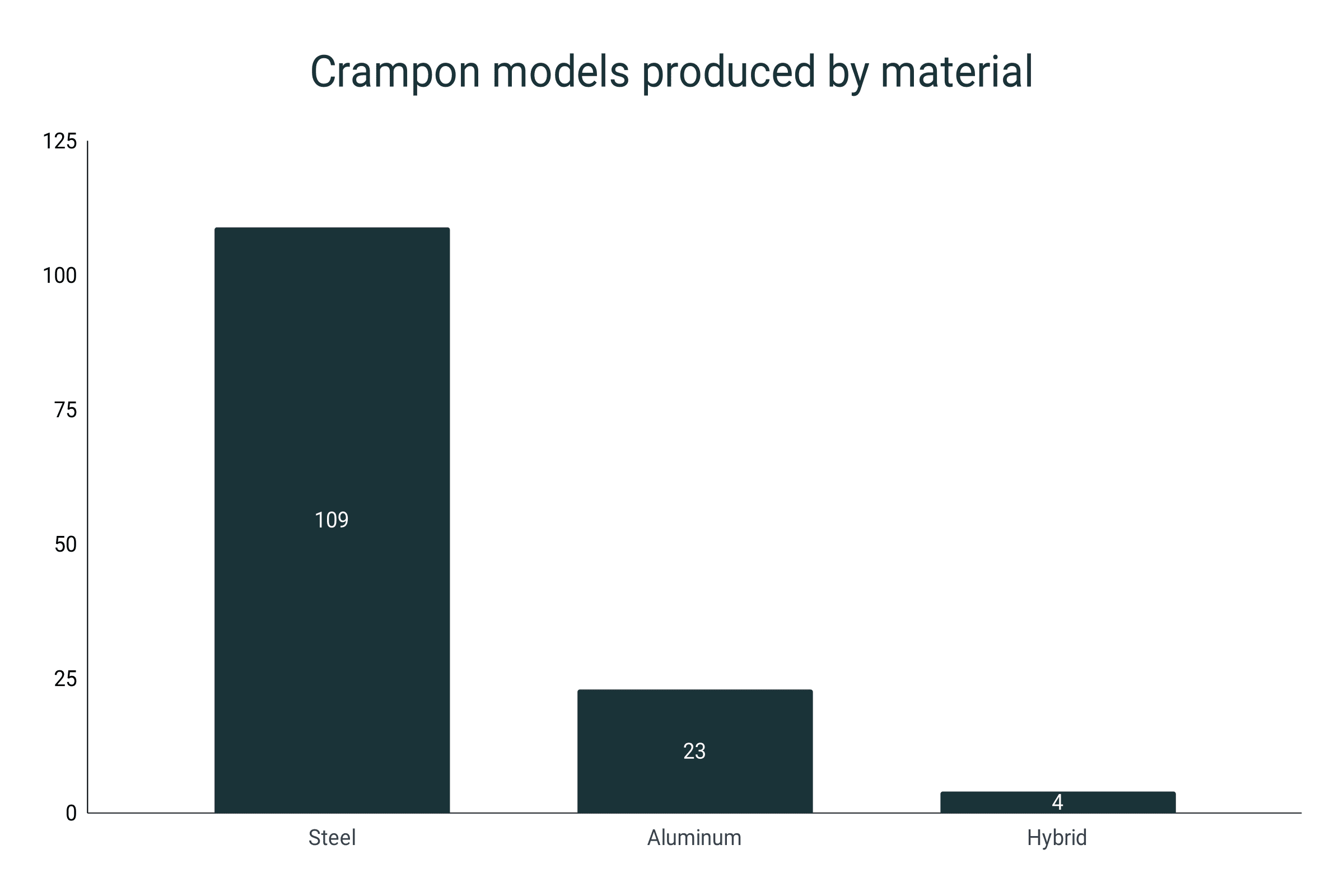
Mountaineering boots FAQS
Can you use mountaineering boots for hiking?
- For trail pursuits, regular hiking shoes and boots are ideal.
- That said, B1 mountaineering boots, while stiff, can be used for short hikes along the approach, which is more about convenience since you don’t need to switch.
- They’re heavier than most trail and backpacking boots, so hiking in them for extended periods can lead to leg muscle strain.
What is the difference between hiking and mountaineering boots?
- Mountaineering boots are more solidly built and rigid than most mid-top hikers, making them heavier but stabler and more protective on mountainous terrain.
- Their stiffness allows strap-on crampons to gain a firmer hold of the shoe; regular hiking boots have a level of upper flexibility that makes them incompatible with C1 crampons.
- Mountaineering boots are built for technical climbing, while hiking boots are generally used for lower-elevation adventures with little to no ascents involved.
Is it worth buying mountaineering boots?
- While they can be quite expensive (averaging around $450), mountaineering boots are valuable and irreplaceable on technical climbs, especially on steep and higher-elevation ascents.
- Compared with other footwear types, mountaineering boots are considered a serious investment.
- In light of that, renting mountaineering boots might be the way to go for the curious.
Sources
Mountaineering Boot Grades Quick Guide | Base Camp Magazine
When to Double Up - Mountaineering boots: single or double? – Mountain Equipment
Crampon Guide | How to Choose – Blog | Synergy Guides
https://www.ellis-brigham.com/crampons/crampons-buying-guide#:~:text=C2%20crampons%20use%20a%20plastic,climb%20hard%20when%20called%20on.
high altitude mountaineering boots — 7000M - 8000M+ Expedition blogposts. Useful articles for high altitude mountaineering | Namas Adventure
All the 41 Brands that Make and Sell Mountaineering Boots - WeighMyRack
https://dataintelo.com/report/global-crampons-market/
A Graphical Guide to Crampon Sepcs (weighmyrack.com)
Hiking in Mountaineering Boots: Is It Really a Good Idea? (mountainhomies.com)
Difference Between Hiking and Mountaineering Boots? (Comparison Guide) (trailandsummit.com)
Beginners Guide To Buying Mountaineering Boots - Be in the Know - 2023 (thehikingadventure.com)
Should You Buy or Rent Alpine Mountaineering Boots? (yamnuska.com)
